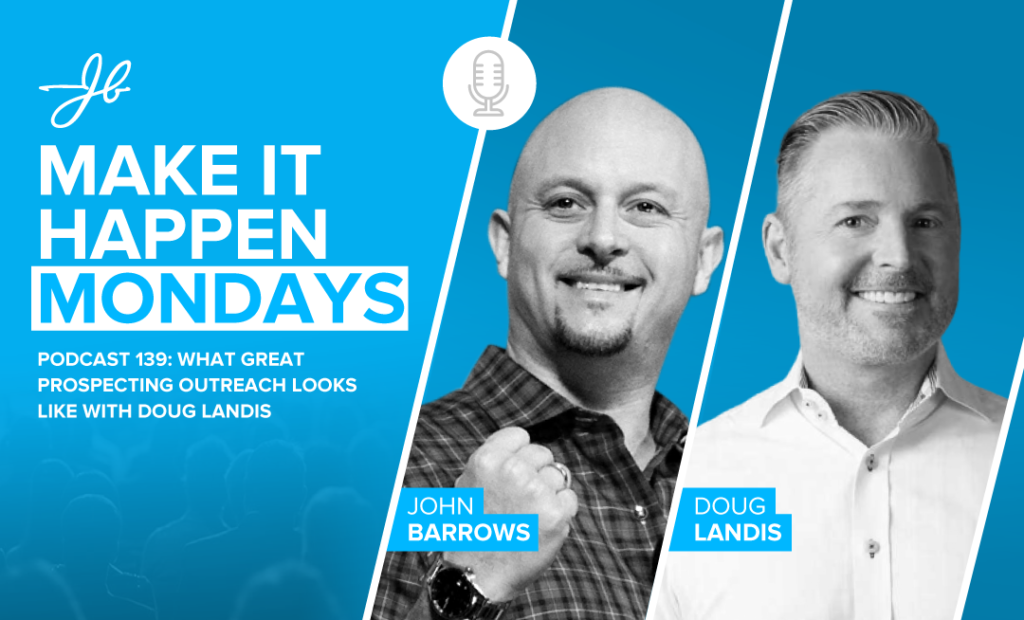We’re pleased to welcome a good friend of the team onto the podcast this week, Doug Landis joins us not too long after he sat with John and Keanu Reeves in the airport watching the Superbowl. They agreed to talk about all of the good, bad and indifferent prospecting outreach they receive and to work out how and why the best ones worked. It’s easy to give sales reps a hard time for “bad” prospecting, but here’s a look into what they can add into their prospecting outreach to go that extra mile and get the appointment…
In This Podcast You’ll Learn:
- Personalization, Relevance, & Timing
- Writing the Right Message
- Empathy and Experience in Prospecting Outreach
Follow The Podcast:
Subscribe on iTunes.
Subscribe on Spotify.
Personalization, Relevance, & Timing
John: For the reps who are going to be in the SDR role for the next 30 days, three months, or six months, the level of personalization doesn’t matter. I mean maybe just one day when you move up in your career that person might remember you. If you’ve got a married short term results, you have to focus on building brand and being relevant. It’s not about personalization, it’s about relevance.
Doug: I’m on the kick now where personalization is overused. Just because you happen to know that someone’s got a two-year-old daughter doesn’t mean that I actually want to engage and have a conversation with you. Just like if you know that I went to University of Oregon or I’m a surfer or whatever it is, there’s got to be a connection. This idea of personalization at scale is a total oxymoron because how can you actually do that? For me, and part of what the CIO is talking about, is it’s about timing and relevance.
I think a lot of times it feels like as a buyer, that’s your objective. It’s always just to get a meeting and part of what the CIO was saying yesterday, share something interesting with me about my competitor. So it makes it relevant. And then wait, guess what? If your message is relevant and the timing is right, now engage. It’s about timing and relevance.
Writing the Right Message
John: Let’s say I write an email where I say “Hey, we do sales training, consulting, we do prospecting, meeting, execution, negotiation, objection handling, closing”. Like those are the five things I do, right? I could probably wrap a nice tight little message. But say, I send you that email or leave that voicemail and you don’t respond. What is my next email?
Doug: If you send me that email or that voicemail, I’m thinking “overkill”. However, let’s just say, I worked for a company and one of our competitors just raised a ton of money. So you know that I will likely struggle in my sales conversations because then that’s going to come up often. And so based on that knowledge, what you might anchor around is just objection handling.
Empathy and Experience in Prospecting Outreach
John: How important is empathy?
Doug: I think, you know, at the end of the day, the more you know, and the more you understand, the more you can empathize and it’s really important to know that consultants use words like “might” and say “I have a hunch” and they don’t say “you do” and “you have”. Saying things like “my hunches” or “this reminds me of the situation with this company and here was their scenario”, basically what you’re doing is you want to build that narrative around that situation or that moment in time that you’ve chosen as your anchor point.
There is my point and the reason why I’m reaching out. This is just like storytime. I’ve got a point and there’s going to be some contrast. Here’s where that company was before, here’s where that company is afterward. My hunch is you’re experiencing or you might be experiencing something similar.
John: How do you have empathy without experience?
Doug: Yeah, you’re a 22-year-old kid and reaching out to 50-year-olds? I’ve got two points in there. First of all, if you’re an SDR, 22-year-old kid, don’t reach out to C-suite. I’m sorry. Just don’t, it’s just the truth. Even just using their email address, it can’t come from you because they don’t give a sh*t. Like you’re just in SDR that I can tell. I want to talk to somebody who is in my mind, my peer, they’ll bring value to you. They’re going to bring value because they have a level of understanding and to my belief that will make our conversation more relevant.
But the other thing is in order to build empathy, you have to understand them. In order to understand them, you have to put yourself in their shoes, in order to put yourself in their shoes, you’ve got to understand their business, how they make money, how they are measured, understand core business acumen and have a business conversation, not a feature conversation and certainly not a conversation about you. Unfortunately, a lot of people are terrible at having business conversations. If you are an SDR and if you’re reaching out to a business that you think is a good fit for your product, you have to understand why is that a good fit? And that to me is how you can start to build empathy.
That’s a wrap. Join us next time
If you made it this far, you’re the best. Thanks for reading and listening to this podcast. We hope you gained a ton from it and will listen in next week too. Don’t forget to check out our recent podcast episode highlights too.
If you have some feedback for us, connect on LinkedIn. And don’t forget to share the podcast on social media.







